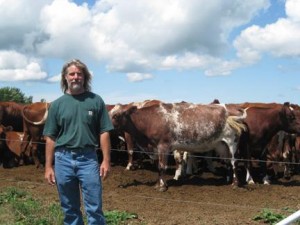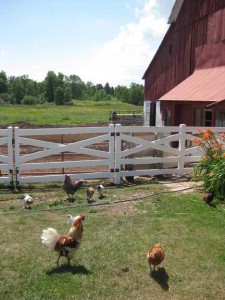An Art, Not a Science
- Share
- Tweet
- Pin
- Share
“Hey, guys,” Lynn Utesch says as he approaches the cattle who have gathered at the edge of his pasture for an afternoon drink of water. The 24 cows and handful of calves in this part of the pasture make up a portion of the herd from which Lynn and his wife, Nancy, produce 100 percent organic, grass-fed beef at Guardians of the Field Farm in Alaska, Wisconsin, just south of Algoma.
“We run it on as much of a natural cycle as possible,” Lynn says about Guardians of the Field. Unlike most beef-producing farmers, Lynn and Nancy use a rotational grazing system, designed to mimic the prairie-roaming patterns of a bison herd. In order to replicate the effects of nomadic buffalo on grass, Lynn moves his cattle every few days to a different section of pasture, using a portable electric fence to control the herd’s location.
“With continuous grazing, the old way,” Lynn explains, “cows had the whole pasture. It would look like a lawn, a golf course. And we don’t want that.”
Lynn isn’t talking about simple aesthetics here: unlike short grass, long grass provides a host of nutritional benefits to both the soil and the cattle. With rotational grazing, the Utesches are able to feed all their cattle and still maintain the health of their 150-acre pasture. What the cows don’t eat in the summer, Lynn bales for winter hay. In fact, in the five years since the Utesches moved from their farm on Washington Island to their current location in Alaska, they have yet to need any outside food for their cattle.
The cattle at Guardians of the Field are shorthorns, an old breed originally brought to the U.S. for the tender, marbled beef they provide. Shorthorns are smaller-boned than most of the cattle currently used for beef in the U.S., which means that they add meat to their frame in the months when other breeds are still building bone structure. And while Lynn restricts adult cattle to one portion of the pasture at a time, he allows young cows to roam anywhere they want in search of the most nutritious grass, encouraging fast, healthy growth. Lynn estimates that his pastures offer cattle between 50 and 100 species of plants to choose from and trusts the cows to choose the nutrition that would be most beneficial to their health
“They know what they need,” he says. “Contrary to what most farmers will tell you, cows are great if you allow them to be a cow.”
Indeed, the grazing patterns at Guardians of the Field seem to be working well. By the time Guardians of the Field steers are sent to slaughter when they’re 18 months old, they weigh, on average, 1,200 pounds.
Lynn and Nancy have worked hard over the years to maintain and improve the quality of their cattle.
“Our oldest cow is 17,” says Lynn. “That’s unheard of in the dairy industry right now. And they really don’t have any health problems. The last time we had a vet on the farm was five years ago – and that was for a horse!”
Lynn credits his herd’s health primarily to the relaxed, natural lifestyle of the farm. His cattle are given no grain, antibiotics, or hormones, and the farm’s pastures are treated with no pesticides, insecticides, herbicides, or chemical fertilizers. These practices foster a healthier farm ecosystem overall, minimizing the need for the chemical corrections favored by many conventional cattle farmers. Grass-fed cattle, for example, produce low-odor, all-natural manure that cycles quickly back into the soil of the pasture, allowing grass to grow without chemical fertilizers. And the sheep that also live at Guardians of the Field have complementary parasites to the cows’. In other words, the cows’ feeding patterns neutralize the parasites that would normally be harmful to the sheep, and vice-versa. As a result, the cows don’t even need worm medication.
The easy pace of life at Guardians of the Field is also vital to the cows’ health.
“If a cow is stressed,” Lynn explains, “its level of adrenaline is higher, which leads to tough meat.” So the patterns of life at Lynn and Nancy’s farm conform as much as possible to the natural patterns of bovine life.
“The cows are naturally weaned; we don’t separate them from their mothers at any time,” Lynn says. “The only thing we do is keep the bull [separate from the cows], because he doesn’t know there’s a cycle. It’s not healthy in Wisconsin to have calves in January!”
Even when Lynn and Nancy prepare their cattle for slaughter (all the cattle are processed at Otto’s Meats in Luxemburg), they try to minimize the stress of the situation, allowing a full day for the cows to load at their own pace.
These efforts are not in vain; by all reports, the meat produced by the Utesches’ grass-fed cows is more tender and flavorful than the beef produced at conventional grain-fed farms. Older customers report that grass-fed beef tastes more like the beef they ate as children, before grain-fed beef became the norm in the U.S.
In keeping with the idea of a small, family-based operation, Lynn and Nancy sell their meat directly to customers, most of whom are local and many of whom visit the farm in person to see where their meat comes from.
Lynn and Nancy are proud of the beef they produce, but the quality of their final product is not the only reason they strive to keep their farm as natural as possible. They also believe in the principle of providing a good life for their animals.
“Even though we’re doing something that at the end is going to be slaughter, that animal is having a good life,” Nancy says. “After all these years, we have a really profound gratitude for what that animal is giving back to our family.”
Lynn and Nancy are proud of Guardians of the Field and are eager to keep learning new ways of keeping the farm healthy and natural.
“There’s a lot of art to this,” Lynn agrees. “We don’t make it into a science, because you have to work with nature.”
Nancy concurs. “Nature has always known better than us, right?”


